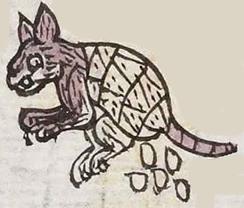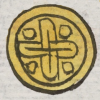Ayotochcuitlatla (Mdz13v)
This compound glyph for the place name Ayotochcuitlatla (or Ayauhtochcuitlatla?) features a hybrid animal, half armadillo (ayotochtli) and half rabbit (tochtli). But the rabbit is a phonetic complement. The animal is defecating. Excrement is cuitlatl. The animal is shown in profile, facing to the viewer's left. The front half of the animal is the rabbit, a purple color (except for white teeth and a white eye). The back half of the animal has an armadillo coat, tail, and hind legs. The armadillo part is white, segmented, and textured. The excrement is shown in five pieces, all of them white. The locative suffix (-tla or -tlah, showing the glottal stop), which means place of abundance, is not shown visually. The reduplication of this syllable could support some added abundance.
Stephanie Wood
If the ayotochtli, or armadillo, is simply shown to approximate the name, the gloss that starts with Ayauh- could be correct, but Frances Karttunen believes that the place name should properly start with Ayo-, as shown in this record. The excrement provides another phonetic part (cuitlatl) of the place name, but Karttunen takes it at face value when translating the place name, too. While we can see teeth protruding from the mouth of the armadillo, these do not provide for the usual visual for the locative suffix (-tlan). So, we are going with the -tla locative suffix, as provided in the gloss, which points to the "abundance" in the translation. Berdan and Anawalt mention that the armadillo is discussed in the Florentine Codex (1950–1982), Book 11, p. 61, and in Hernández 1959, vol. 2, pp. 296–297.
Stephanie Wood
ayauhtochcuitlatla. puo
Ayotochcuitlatla, pueblo
Stephanie Wood
c. 1541, or by 1553 at the latest
Stephanie Wood
armadillos, rabbits, conejos, excremento, nombres de lugares

ayotoch(tli), armadillo, https://nahuatl.wired-humanities.org/content/ayotochtli
cuitla(tl), excrement, https://nahuatl.wired-humanities.org/content/cuitlatl
-tla or -tlah (locative suffix), place of abundance of preceding noun, https://nahuatl.wired-humanities.org/content/tlan
"Where There is Much Armadillo Excrement" [Frances Karttunen, unpublished manuscript, used here with her permission.]
"Where There is Much Armadillo Excrement" (Berdan and Anawalt, 1992, vol. 1, p. 174; they spell it Ayauhtochcuitlatla)
"Lugar de Mucho Excremento de Armadillo"
Stephanie Wood
Codex Mendoza, folio 13 verso, https://digital.bodleian.ox.ac.uk/objects/2fea788e-2aa2-4f08-b6d9-648c00..., image 37 of 188.
The Bodleian Libraries, University of Oxford, hold the original manuscript, the MS. Arch. Selden. A. 1. This image is published here under the UK Creative Commons, “Attribution-NonCommercial-ShareAlike 3.0 License” (CC-BY-NC-SA 3.0).





